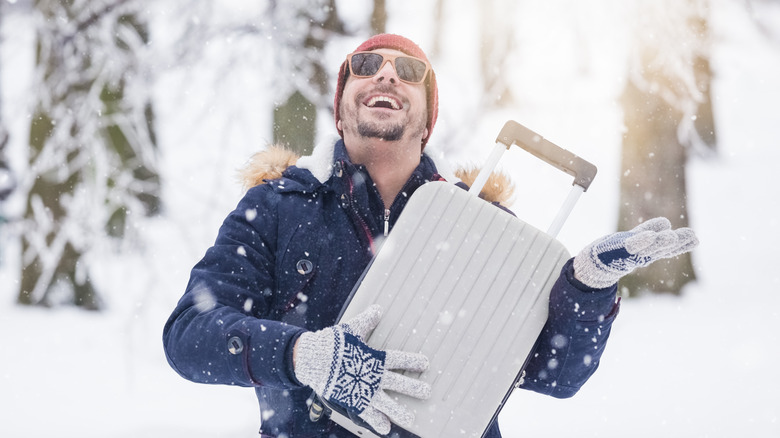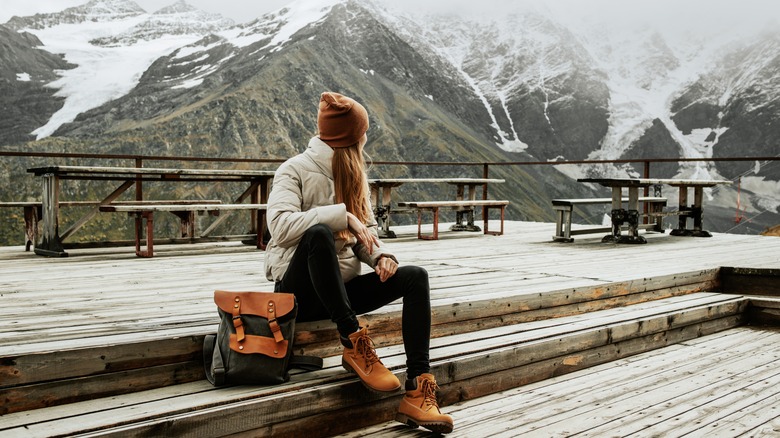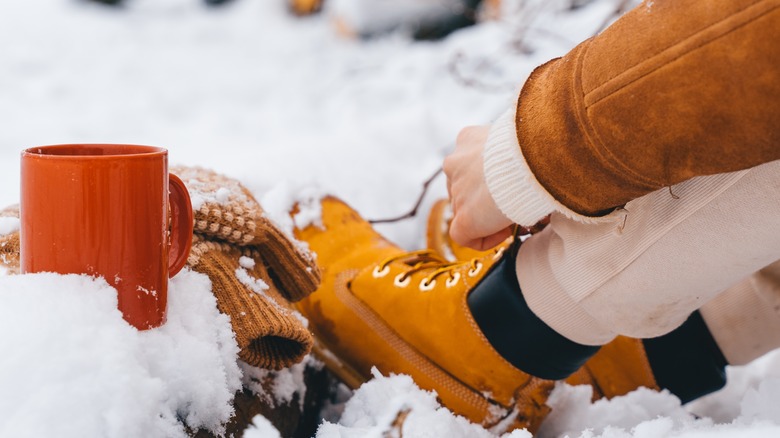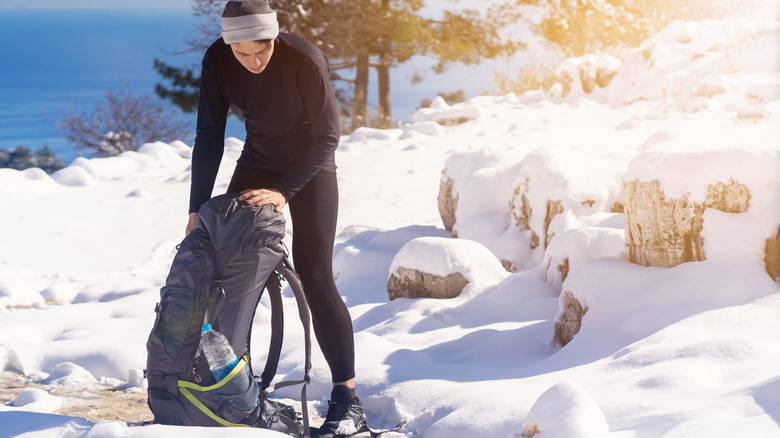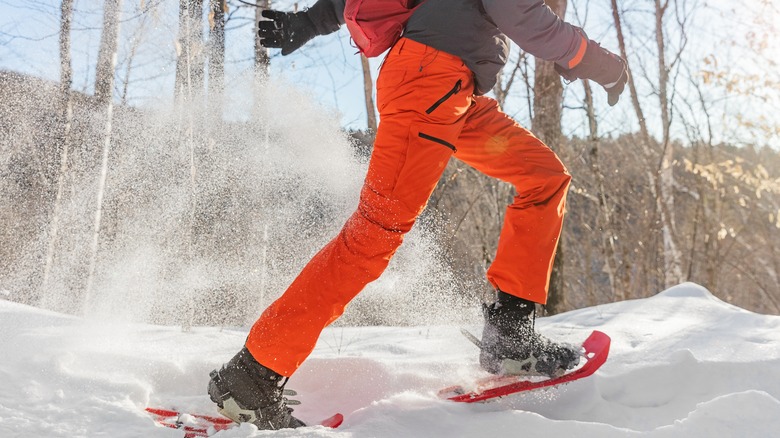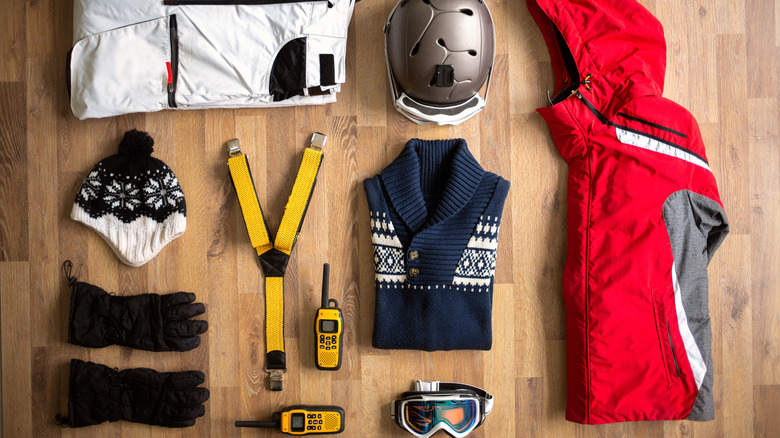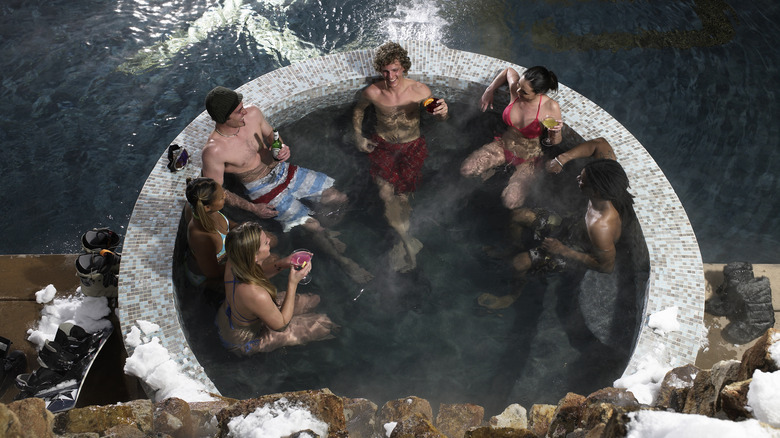Your Guide To Packing For Cold Weather
The practical part of traveling often starts with your suitcase. Frequent travelers typically grab their tried and true packing list any time they are bitten by the travel bug. But, whether it is a winter vacation or simply a cold weather destination, there is a strong likelihood that the standard packing list will not work this time around (via Neverending Voyage). So what can soon-to-be cold-weather wanderers do? Well, first things first, they should plan on using a packing list for cold weather travel or get ready to compile one if they do not have this particular packing list handy.
In general, packing for cooler climates and wintery weather can be challenging, especially if the goal is to pack light (via Passport & Plates). Still, the last thing you want on your getaway is to be freezing cold or ill-equipped when it comes to surviving the elements. But before you start packing heavy sweaters, adult winter onesies, and crafting your cold-weather defense for your entire trip, there are definitely a few important things you should keep in mind when packing for cold weather.
What to know about packing for cold weather
Even if you are not headed to snow-covered places, it is still important to pack appropriately for your destination (via Practical Wanderlust). Depending on your planned activities, you might need to be able to withstand lower temperatures, higher humidity (which makes it feel even colder outside), and overall less-than-amenable weather for several hours on end. Nevertheless, these things are often overlooked by travelers, especially if they are coming from warmer climates or a location that has little to no humidity.
Of course, no one can truly predict the weather. But you can still be proactive by staying on top of expected changes in temperature and considering the seasonal weather at your vacation spot when assembling your trip attire. That said, travelers off to cooler destinations should still pack with purpose. This means packing as lightly as possible (aim for no more than a week's worth of clothes regardless of trip duration) and utilizing several space-saving hacks like rolling clothing items and picking the right travel accessories (via Get Your Guide). Doing so will ensure that you are properly prepared for whatever weather does come your way without needlessly overpacking.
Outerwear and winter accessories
Unsurprisingly, there is not much wiggle room when it comes to outerwear and cold-weather vacations. Thus, at the top of your cold weather packing list should be the proper outerwear or coat. Heavy, warm (well-insulated), and waterproof jackets are usually a must when exploring snowy mountain ranges, chasing the northern lights, hitting the slopes, and so on. This necessity, however, will most likely be on the bulky side. So, it is better to wear your coat or outer layer on the plane (via Wear She Wanders). Not only will this save you much-needed space in your suitcase, but it will also keep you warm once you exit the airport and as you embark on your trip.
Similarly, winter accessories like scarves, gloves, hats, earmuffs, and warmers can be stowed in your coat or in your carry-on for quick and easy access. Besides these key accessories, travelers headed to colder parts of the world should remember to pack a cozy cardigan or fleece. Being able to layer up is a crucial part of staying warm but still packing light, so something you can throw on with ease, like a cardigan, hoodie, or fleece, is essential and makes for a great insulation layer. To protect yourself from all the elements, make sure you pack other essentials like sunscreen, chapstick, balaclavas, high-quality polarized sunglasses, walk traction cleats, oversized scarves, and hats or beanies — placing both the larger and personal care items in your checked bag.
Footwear and socks
Yet another essential item for your winter trip is your chosen footwear. Boots are almost always a must, and it is a good idea to make room for them in your suitcase early on in the packing stages. Everyday walking shoes that are easy to slip on and off are perfect for the airport (via Travel Fashion Girl). But travelers should expect to pack three pairs of winter shoes — comfortable boots (ankle boots or hiking boots are fine), tall weatherproof boots, and possibly a wedge boot for the ladies or nice dress boot for guys.
In addition to this footwear, travelers should pack the necessary socks. Clearly, with three pairs of boots, you will need several pairs of thermal, winter, and boot-friendly socks. A few regular pairs of socks for those days you happen to be lounging about or are headed to the airport don't hurt, either. For the best of both worlds, travelers can also invest in a pair or two of hot socks, which are a combination of indoor slippers and boot liners — so your feet can stay warm and comfy no matter your location. An added bonus here with all these packed pairs of boots is you can roll up all your socks and other undergarments and store them in your winter shoes to save space (via Away Lands).
Base layer
Having a base layer and being able to layer clothing, in general, can help keep travelers nice and cozy. Typically, for cold weather getaways, four layers of clothing are recommended — base, mid, insulation, and shell or outer layer. That said, thermals or long johns are typically the best options for a base layer, especially if you are going to be out adventuring for most of your trip. Today's long johns or underwear come in a variety of styles, which is great. But, when packing for your winter getaway, it is important to pay attention to the type of material (merino wool, silk, ceramic wool, and synthetic fabrics are the most common). So if your cold-weather itinerary is full of outdoor fun, then make sure to pack at least one pair of merino or ceramic wool thermals (via Learning Escapes).
Lightweight or more breathable thermals, on the other hand, like those made from silk and synthetic fabrics, are good options for keeping toasty with less bulk. But, as a base layer, these kinds of long johns aren't necessarily suitable by themselves for hours on the slopes. With that in mind, one to two sets of non-wool long underwear (in addition to your one wool pair) are ideal for shorter jaunts with limited outdoor exposure. Even if you have a longer stay planned, you don't have to overdo it — a max of three pairs of silk or synthetic moisture-wicking thermals and two pairs of wool long johns should do just fine (via Travelista).
Tops
As briefly mentioned, layering is your friend when vacationing in colder climates, and tops are considered your mid-layer, i.e., the layer after your thermals. While putting together your vacation attire, it can be very tempting to grab bulky sweaters, turtlenecks, and other heavy tops that you think will help you better face the elements. Well, think again. Packing several lightweight tops is actually the way to go here. Not only are light tops and shirts great for layering, but they also tend to save on space. So you can customize your level of cozy while having more than a few options in terms of outfits (via Parks Collecting).
However, travelers should be careful when choosing their cold-weather shirts and tops — remember, the goal is to retain body heat, not become sweaty. If you overdo it with your layers and your base layer becomes saturated with sweat, expect it to be chilly. Moreover, cotton blends for a mid-layer or really any layer are dangerous territory as they are the opposite of moisture-wicking and thus can lead to hypothermia (via Backpacker). So, what should your mid-layer be made of? A combination of wool and polyester is best, though either wool or polyester will suffice. This means that long sleeve crew tops, flannels, polo shirts, pullover knits, and tops specifically designed for cold weather wear should all be on your list. Pro tip: using compression packing cubes and rolling clothing can make a world of difference with multiple items such as these.
Bottoms
Obviously, if you plan to spend a lot of time outdoors, then long johns, long underwear, or thermal pants are already on your list. You know that using these clothing items as your bottom base layer is crucial to staying warm and dry while adventuring in colder climates. But, of course, the fun definitely doesn't stop there. Travelers headed to cold weather destinations need at least an additional layer over their thermal bottoms or pants (via One Girl Whole World).
Regardless of your planned activities or the amount of time you expect to spend outside, layering up is yet another must that you won't regret. Whether that looks like snow pants or a ski suit is up to you. Of course, regular winter trousers or loungewear pants are more than suitable for the days spent in the mountain lodge, resort, or cabin. Likewise, fleece-lined leggings, cold-weather hiking pants, outdoor jeans (water-resistant), and even joggers or regular athletic bottoms over your base layer thermals are all quick fixes for fighting off limited exposure to the cold. So you have some options, though typically three to four pairs of bottoms, give or take a snowsuit or ski pants, are all one needs to pack for winter travel (via Passports & Plates).
Casuals
An extensive part of cold-climate travel is spending ample time outside weathering the elements. Moreover, most wanderlusters who are cold weather enthusiasts can't seem to get enough of the great outdoors, no matter the temperature. But, there will be times, possibly even days, when you will not be out and about in the cold. So, it is in your best interest to pack accordingly, not just for below-freezing temperatures or fun activities in the surrounding winter wonderland (via Backpacker Travel). Of course, this does not mean you need a completely separate wardrobe for being snowed in or enjoying a lazy afternoon by the fire. But there is no denying the simple fact that you will need the basics.
Like warm weather travel, you will need pajamas, undergarments, loungewear, and other casual yet still essential clothing items. Sure, in this particular instance, your thermals can double for most of these things in a pinch. But unless you feel like washing your clothes and hoping that your winter attire is fully dry in time for your outdoor excursions, you might want to rethink having your thermals pull double duty. Instead, pack at least one or two loungewear sets, multiple pairs of pajamas, and an adequate number of undergarments. And if you are worried that these items will take up too much space in your luggage, remember you have compression packing tubes and all that extra space in your boots. So, there is really no reason why you cannot include these essential items in your checked bag (via Practical Wanderlust).
Active gear
Depending on your planned activities, you may need to head to the airport with your active gear in tow. If you are worried that your equipment might be a tad bulky or even qualify as oversized baggage during check-in, there is no need to panic (via Wear She Wanders). In fact, if your winter getaway is a ski, hockey, or snowboarding trip, there is good news. You can check all your winter sports equipment in one checked bag. However, if your ski boots or other equipment will likely exceed the airline's weight requirements, then you will need to make the necessary packing adjustments prior to heading out or be prepared to pay the additional charges. It is worth noting that the possible additional fees for heavy gear vary from airline to airline (via Ship Skis).
Other cold-weather active gear for hiking, camping, climbing, and backpacking, can also be checked. Though certain items can be brought on board the plane as a carry-on, anything that could be considered a weapon is clearly a no-go, so it is best to check active gear. That said, there are several other ways to ensure you have your gear by utilizing shipping services or opting to rent when you arrive. Travelers can see what storage services are available where they are staying, so they can ship their equipment and have it waiting for them. This is a good option if you happen to frequent the same winter destination spot regularly (via Travel Responsibly Informed & Protected).
Backpacks and suitcases
Speaking of baggage, cold weather wanderlusters should be mindful of what they choose to carry for such a getaway, and this applies to carry-ons, suitcases, and daypacks. In terms of luggage, having user-friendly bags that can easily transition from the airport to the mountaintop and then should absolutely be the goal here (via Outside Online). Carry-on bags that can double as hiking backpacks and make organizing active gear a breeze should also be your cold-weather go-to. Even if you are not planning an all-out outdoorsy experience, having travel luggage that is easy to maneuver (through the rain, sleet, and snow), waterproof, and still lightweight is truly nothing to sneeze at.
Likewise, a sturdy checked bag that can handle whatever baggage claim throws at it while still protecting your ski boots, toiletries, and cozy cardigan should be your first choice when packing for your cold-weather escape (via Practical Wanderlust). And for winter adventurers who like to keep their gear separate but still well-protected, hard-side roller bags that fit your skis or snowboard, snow pants, poles, and more — all while being easy to maneuver and TSA-approved are definitely worth the investment. So if you happen to be one of those avid wanderlusters that is still carrying around a cloth suitcase from the late 1980s, it might just be time for an upgrade. Remember, being well-packed and prepared for anything on your wintery getaway really means nothing if all of your belongings and gear get destroyed en route.
Odds and ends
So you finally finished packing for colder parts unknown. You have your thermals, pajamas, layers, multiple pairs of boots, active gear ready to check in the best suitcase ever, travel-sized toiletries, and all your accessories for your cold-weather getaway. What else could you possibly need? It is a question that haunts the best of us, right before heading out on vacation (via Practical Wanderlust). Sure, it is most likely something small that totally slipped your mind. But thankfully, you created a weather-appropriate packing list with a section for odds and ends.
That said, a common item that travelers forget when heading to cold-weather destinations is something that simply doesn't fit with winter tops, scarves, and snow pants — swimwear. Why would you need swimwear, right? Well, whether it is a hot spring, hot tub, heated pool, or sauna, you probably want to join in on the fun, especially after a long day out in the cold. Even if you are not staying at a ski resort or hotel, many cold climate accommodations know people like to warm up in other ways besides sitting by the fire after an eventful day outdoors. So maybe you booked a quaint little cabin with a private sauna, set up camp near the local hot springs, or perhaps you didn't — but pack a bathing suit just in case. And the best part, swimwear and other odds and ends like this don't need to take up prime luggage space (via Backpacker Travel).

